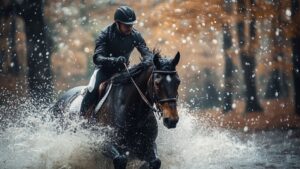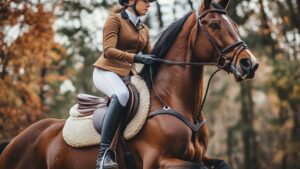Horseback riding is an exhilarating and fulfilling activity that creates a special bond between riders and their horses. However, like any sport, it comes with its risks, making safety a top priority. The unpredictable nature of horses, combined with varying terrains and riding styles, can lead to accidents if precautions are not taken. Riders may encounter challenges such as sudden spooks, falls, or the horse’s unexpected behavior, which can pose a danger to both rider and animal.
Equestrian safety experts emphasize that using the right protective equipment can greatly lower the chances of injury, enabling riders to concentrate on having fun while riding. Wearing suitable protective gear is crucial for preventing injuries and promoting a secure riding environment.
Below is a detailed overview of the essential protective equipment every horse rider should consider.
1. Riding Helmet
A riding helmet is perhaps the most critical safety gear for any equestrian. Helmets are specifically designed to absorb impact in the event of a fall, protecting the rider’s head from serious injury. Here are some key points to consider:
- Certification: Look for helmets that meet safety standards set by organizations like the ASTM (American Society for Testing and Materials) and SEI (Safety Equipment Institute).
- Fit: Ensure the helmet fits snugly without being too tight. It should sit level on your head and not obstruct your vision.
- Ventilation: Opt for a helmet with good ventilation to keep you cool during rides, especially in warmer weather.
2. Body Protector
A body protector, or safety vest, provides extra protection for the torso, particularly the ribs and back. This gear is especially important for eventing, jumping, or cross-country riding riders. Consider the following:
- Certification: Look for vests that comply with safety standards like the BETA (British Equestrian Trade Association) Level 3.
- Comfort: Choose a vest that allows for freedom of movement while providing adequate protection. It should fit snugly without restricting your riding posture.
3. Riding Boots
Proper footwear is essential for both safety and comfort while riding. Riding boots provide the necessary support and grip in the stirrups. Here’s what to look for:
- Heel: Ensure your boots have a heel to prevent your foot from slipping through the stirrup.
- Material: Leather or synthetic materials are common, with leather offering durability and breathability.
- Height: Consider tall boots for added leg protection and support, especially for jumping or dressage.
4. Gloves
Wearing gloves enhances grip on the reins and protects your hands from friction and blisters. Look for:
- Material: Leather gloves provide excellent grip and durability, while synthetic options may offer better flexibility and breathability.
- Fit: Ensure gloves fit snugly for optimal control without being too tight.
5. Chaps or Half Chaps
Chaps and half chaps are worn over riding boots and provide additional leg protection while enhancing grip on the saddle. They come in various styles, including:
- Full Chaps: Cover the entire leg and are often used in colder weather.
- Half Chaps: Cover only the lower leg, providing breathability and flexibility.
6. High-Visibility Gear
If you plan to ride on public roads or in areas with low visibility, consider wearing high-visibility gear. This could include:
- Reflective Vests: Bright colors and reflective materials help you stand out to drivers and other riders.
- Accessories: High-visibility saddle pads or leg bands can also enhance your visibility.
7. Saddle and Tack Safety
While not personal protective gear, ensuring that your saddle and tack are well-fitted and in good condition is crucial for safety. Check for:
- Saddle Fit: A properly fitting saddle will help maintain balance and prevent slipping.
- Tack Maintenance: Regularly inspect your reins, girth, and stirrups for wear and tear.
Horse riding is an exhilarating sport that requires a commitment to safety. Investing in the right protective gear helps prevent injuries and enhances your overall riding experience by allowing you to focus on mastering your skills rather than worrying about potential accidents. By prioritizing safety through these essential items, riders can enjoy their passion with peace of mind, knowing they have taken proactive steps to protect themselves in this thrilling and dynamic sport.





